Featured Comment:
“Great recipe and walkthrough, tried this nany times with diffrent meats and it tasted great with all. When in a hurry i do it with bacon tofu also works but needs to marinate a bit longer pref over night and also add abit of togarashi for more taste. Thank you!”
– Karl-Henrik
What is Niku Udon?
Niku udon (肉うどん) is a rich and meaty noodle dish made with thick udon noodles served in a hot dashi broth and topped with thinly sliced beef and onions.
The direct translation of niku udon is “meat udon.” While beef is the most popular, some people use pork instead. The preferred meat used for this dish depends on the region. Pork is often used in Japan’s Kanto (East) region, while beef is common in Kansai (West).
Using beef or pork brings out different qualities in the dish, and I like them both. I would say that beef udon is richer, meatier, and has a slightly more elegant taste!

Visual Walkthrough & Tips
Here are my step-by-step instructions for how to make Beef Niku Udon at home. For ingredient quantities and simplified instructions, scroll down for the Printable Recipe Card below.
If you prefer to watch the process in action, check out my YouTube video of this Beef Udon recipe for a complete visual walkthrough!
If you’re using instant dashi or dashi bags, you can skip this step, but good dashi is an essential element of this dish, so I want to show you how to make my favorite dashi here.
Start by soaking kombu in cold water for 30 minutes. I also use dried sardines with the heads removed (optional).
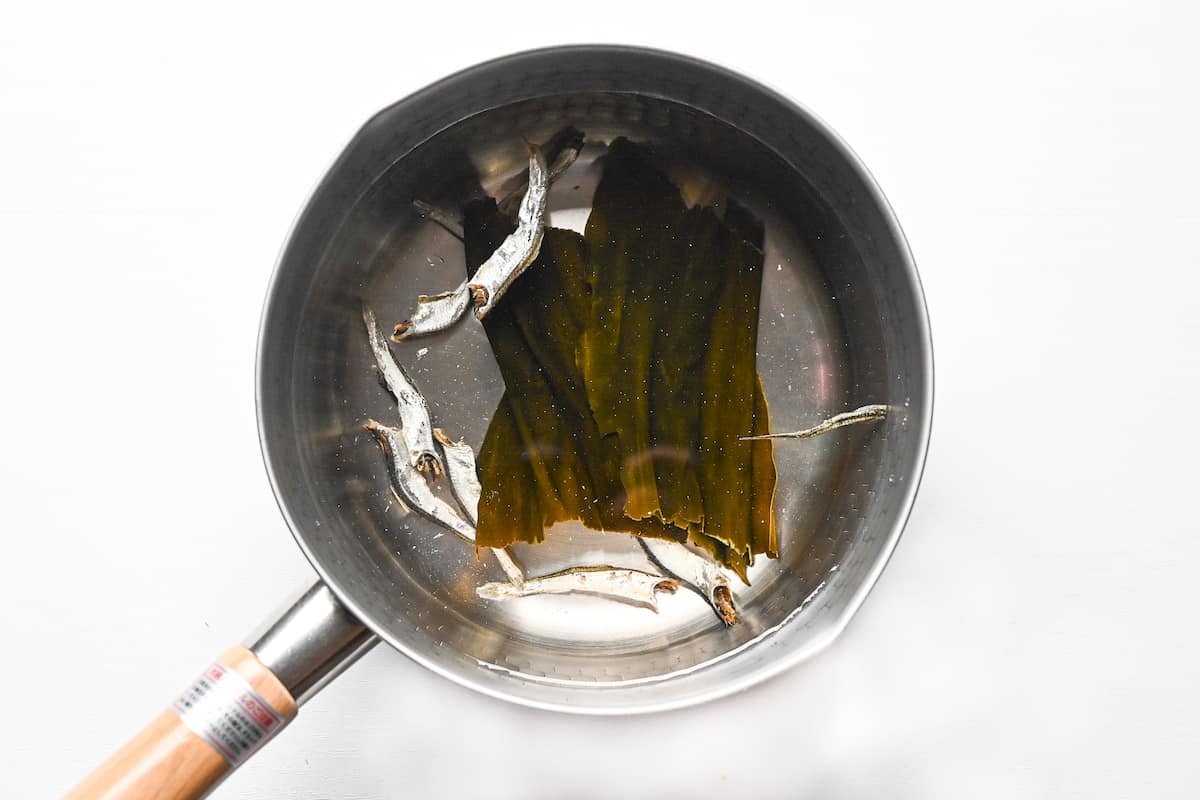
Marinate your beef (the next step) while your dashi ingredients are soaking so that they’re ready at the same time!
After 30 minutes, place the pan on the stove and add the katsuobushi.
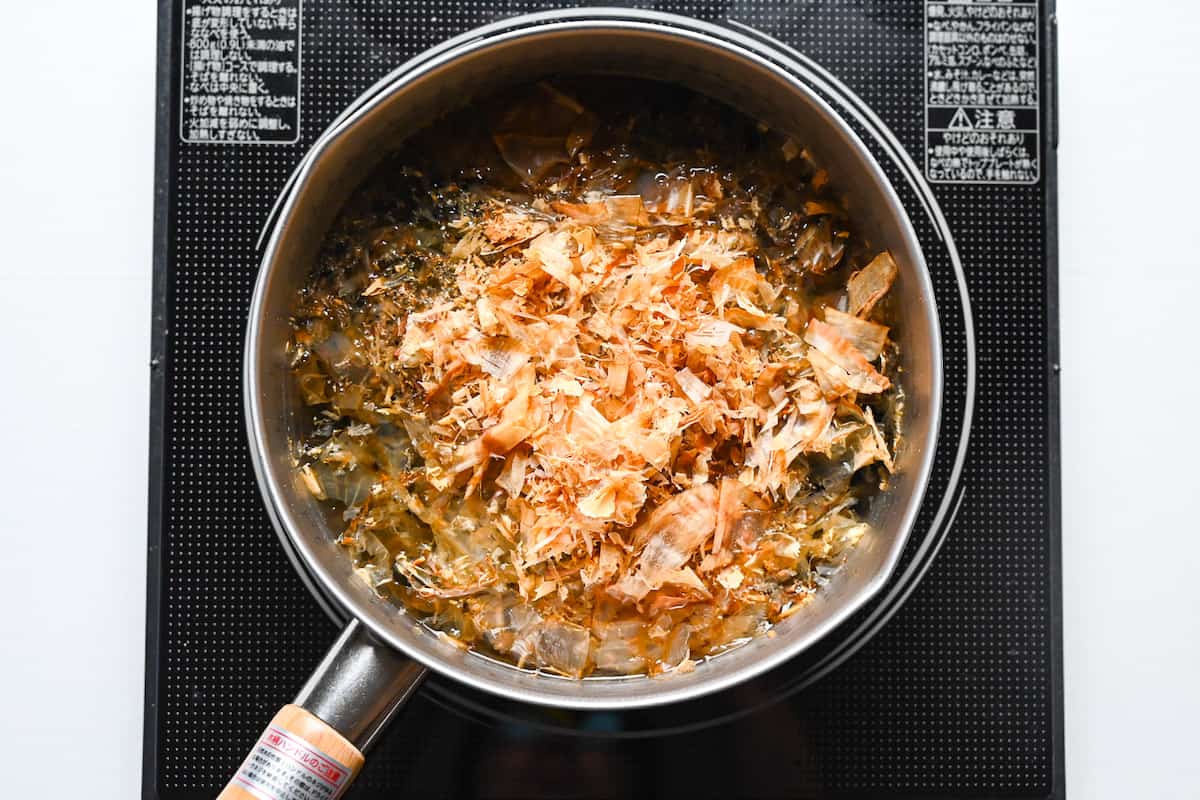
Heat the pan on medium/medium-low and bring to almost boiling. Don’t let it actually boil.
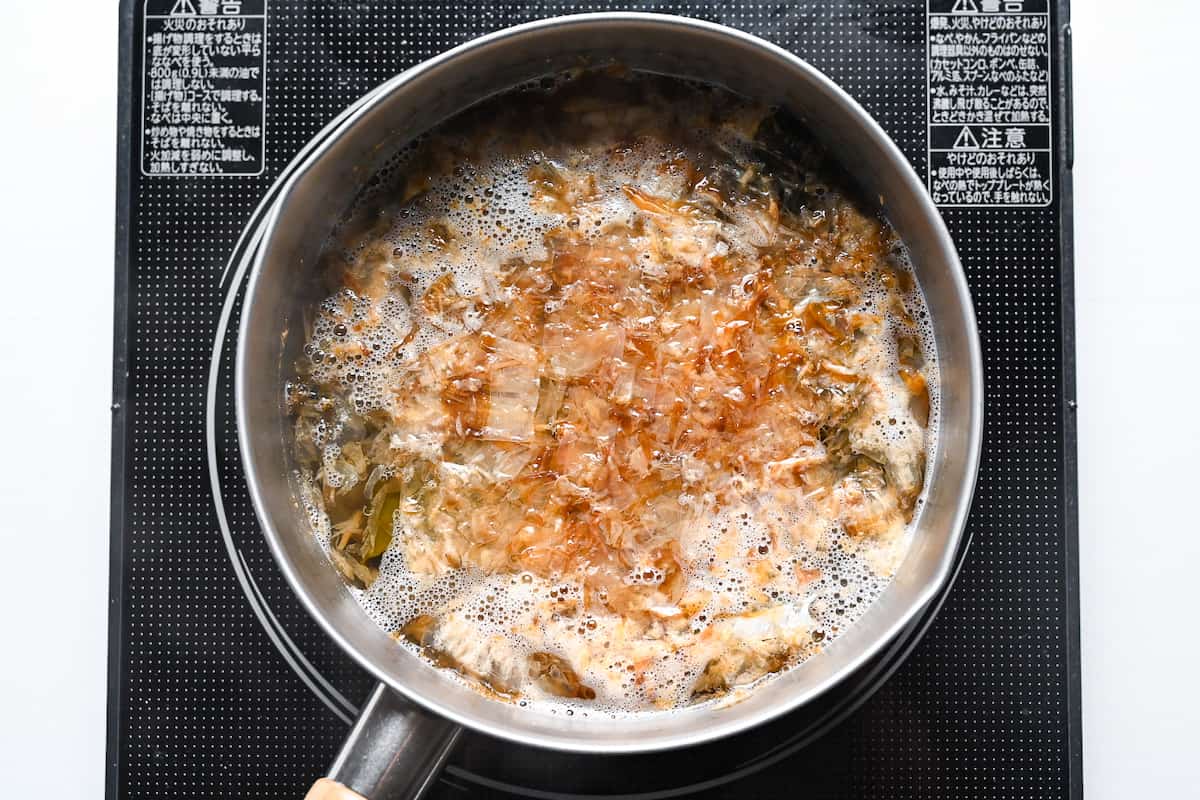
When it simmers gently, turn off the heat and strain it through a sieve lined with kitchen paper.
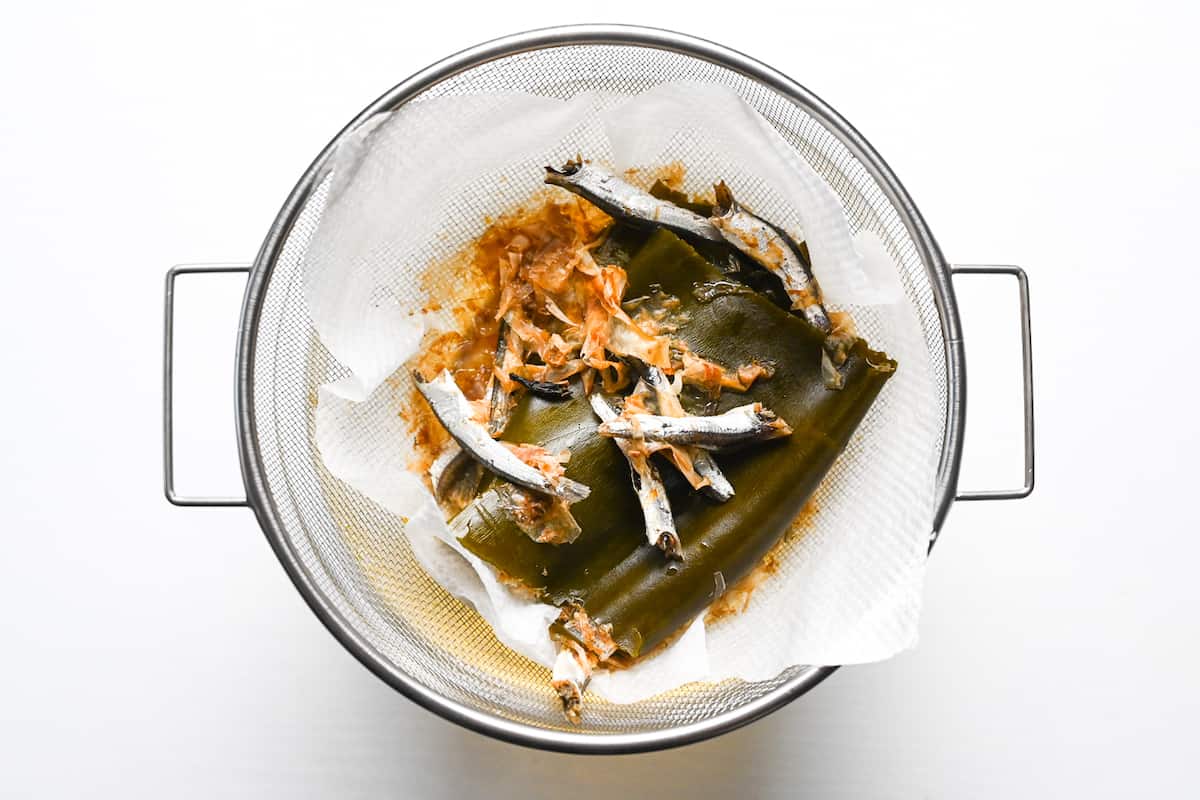
To catch all the fine pieces of katsuobushi, line your sieve or strainer with kitchen paper. This will act as a filter and give you a beautiful clear broth!
The final result should be a beautiful clear golden dashi broth that looks like this:
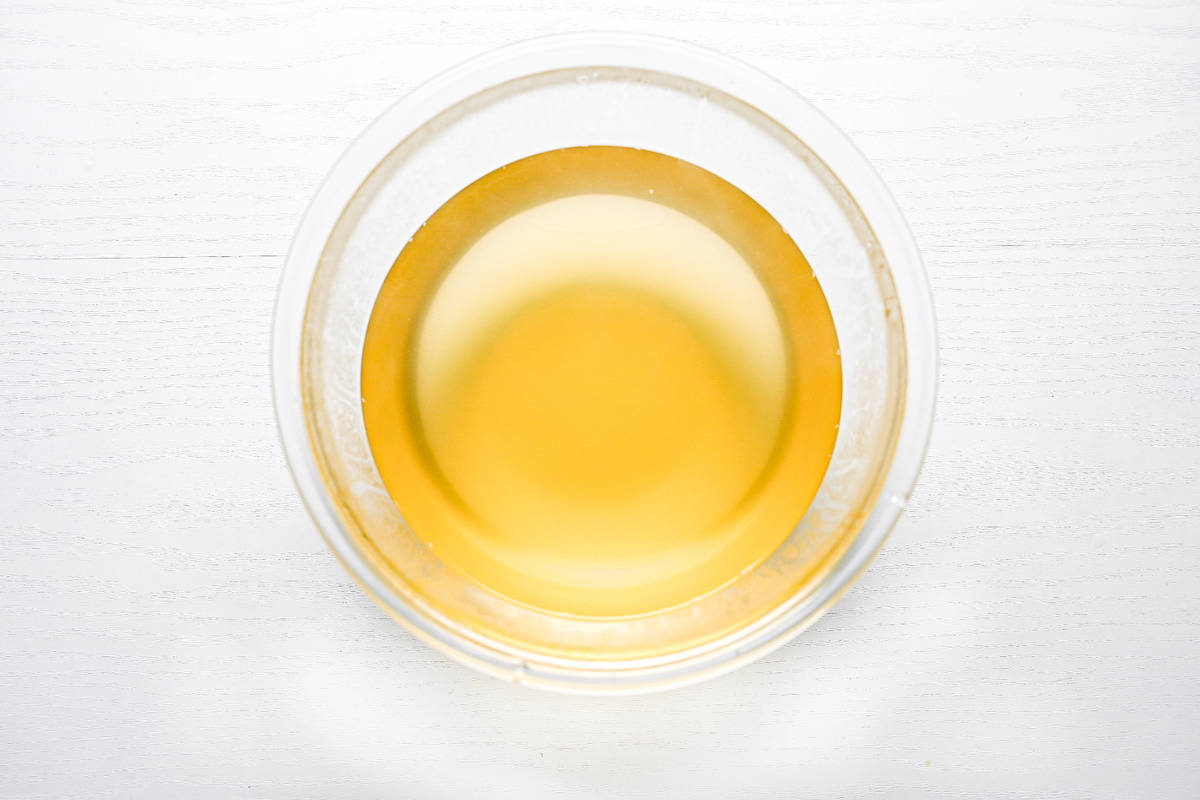
To make sure the flavor of the beef shines through, I like to marinate it before cooking. In my recipe, I soak the beef in a mixture of soy sauce, mirin, oyster sauce, sugar, ginger paste, and salt.
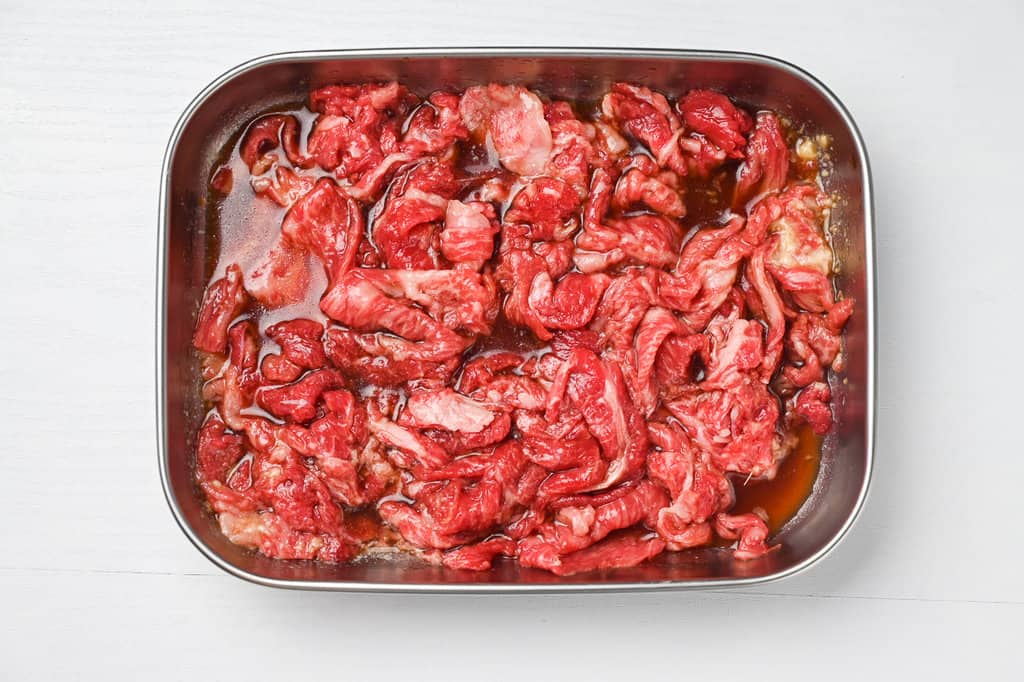
Marinate the beef for at least 10 minutes, preferably 30 minutes. I recommend marinating it while the dashi ingredients are soaking!
Finely slice the onions and sprinkle them with salt. With your hands, rub the salt over the surface.
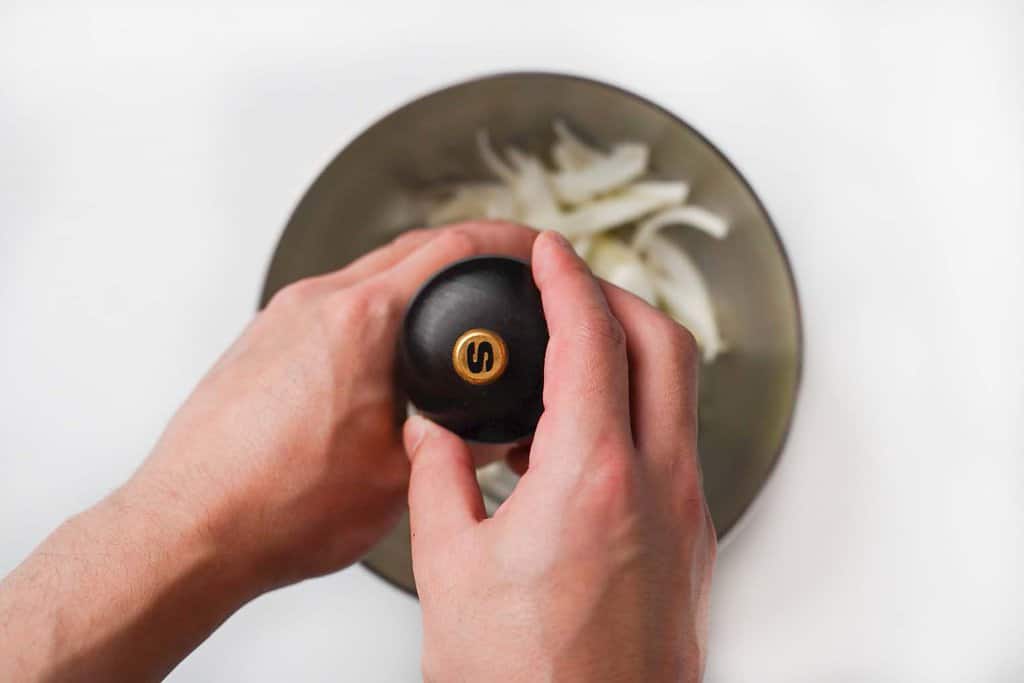
This step is to stop the onions from overpowering the dish. Rubbing them with salt not only tames the strong flavor of onion but also draws out some moisture, which will soften the texture and help them cook faster.
Cook your udon noodles according to the time stated on the packaging. This varies greatly depending on whether the udon is chilled, dried, or frozen.
You can boil your noodles at the same time as making the broth.
I always recommend cooking the udon noodles in a separate pot and washing them under boiling water to remove the excess starch.
It’s also important not to overcook udon! Like pasta, they should be served “al dente” (firm to the bite), and I recommend cooking the udon last when making this dish.
Pour your dashi into a pan and add soy sauce, mirin and light brown sugar.
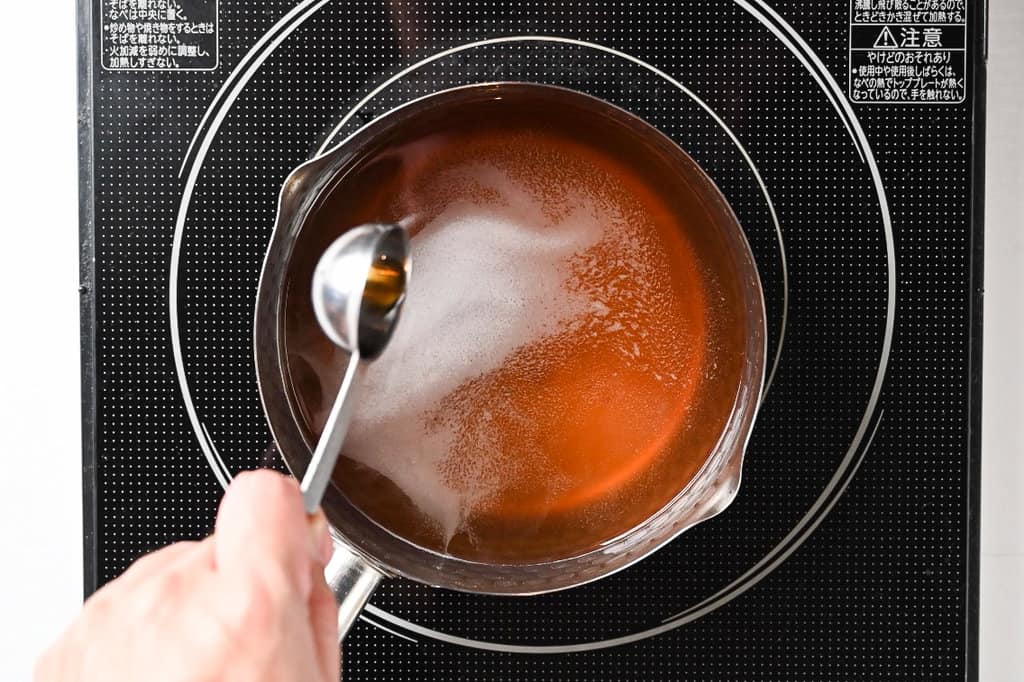
Place it on the stove and bring it to a boil over medium heat. Boil for 2 minutes and then set aside. You can reheat it right before serving.
It might be tempting to leave the broth simmering while you prepare the rest of the dish, but this will cause the liquid to evaporate and the broth to become concentrated and too salty. Set it aside and reheat right before serving.
When making niku udon, I prefer to sauté the onions and beef, then serve them on top of the udon at the end. First, we sauté the onions until soft and then add the marinated beef.
Heat a frying pan on medium and add oil or beef fat. I used beef fat to add more meaty flavor to the dish.
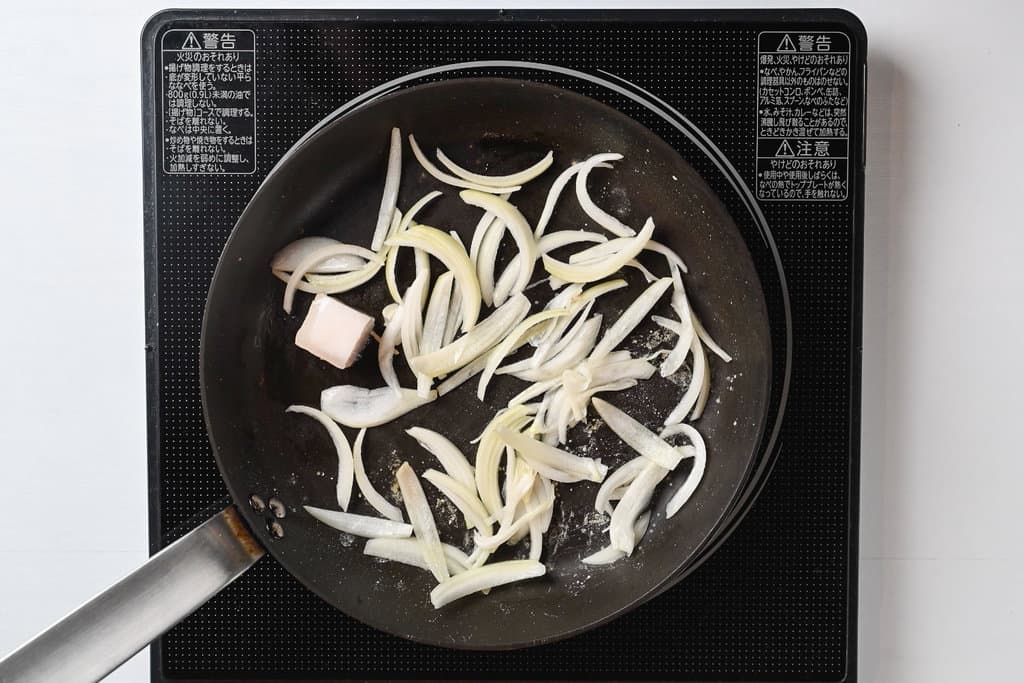
I fry the onions first to soften them thoroughly without overcooking the beef.
Once the onions are softened, add the beef and marinade. Stir fry for a few minutes until the beef is cooked through.
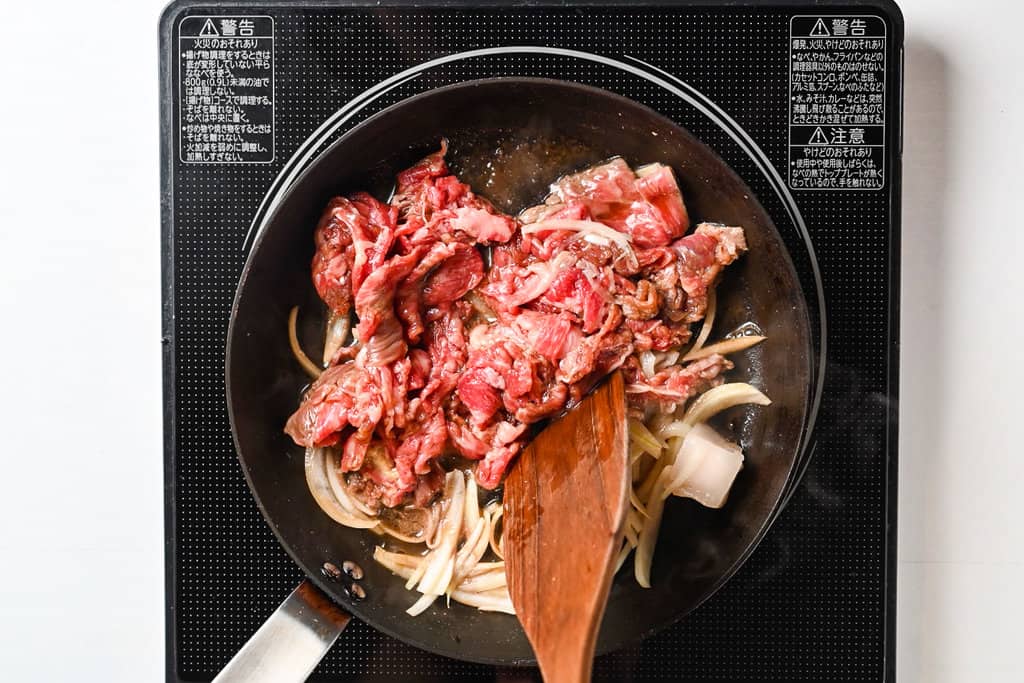
Adding the marinade to the pan is a crucial step because the flavor from the marinade will be absorbed into the onions and beef.
Once cooked, I also pour any leftover marinade in the pan into the udon soup at the end, so it’s necessary to burn off the alcohol in the mirin.
Using the leftover marinade in the broth makes it rich and meaty. This method also reduces waste, and no flavor is lost.
Once the beef is cooked, remove the pan from the heat, and we’re ready to dish up!
First, divide the udon noodles into serving bowls and pour the broth to fill about two-thirds of the bowl.
Place the beef and onions on the top like this:
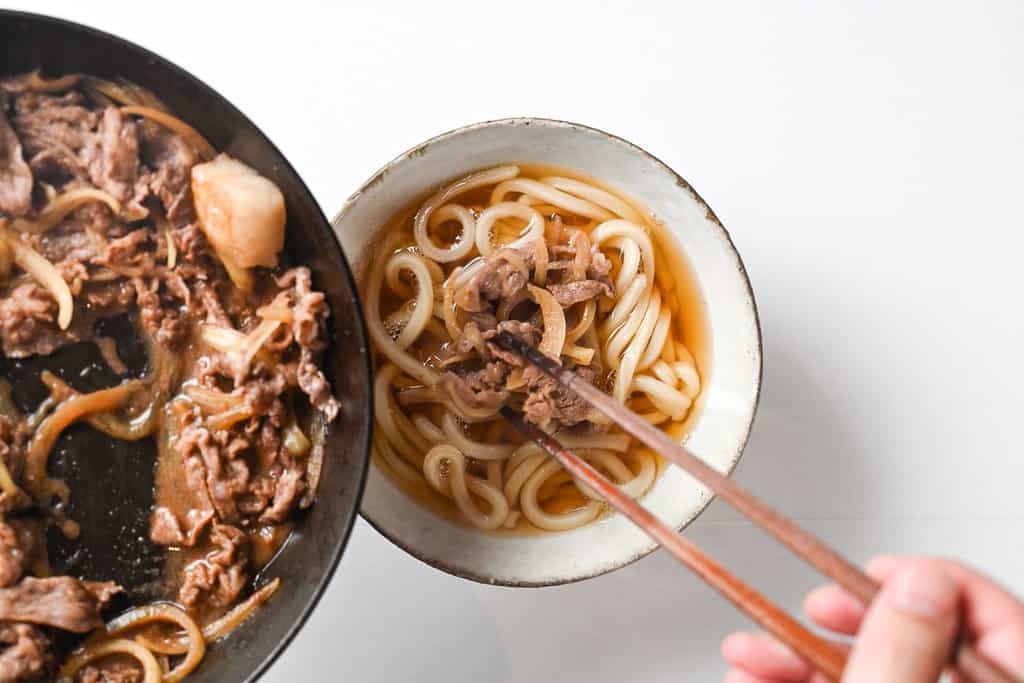
Pour the leftover marinade around the top of each bowl and garnish with chopped spring onions and a sprinkle of Japanese “shichimi” chili pepper. (Optional)
Jump to Full Recipe Measurements
FAQ
Here are answers to frequently asked questions I have received across all platforms, including here, YouTube, Instagram, and Pinterest. If you have any questions, feel free to send them to me anytime! It will be a big help for everyone in this community!
It will have slightly different flavor in terms of depth and sweetness without mirin. Maybe you can add a tiny bit of extra sugar where mirin goes in (but not the same amount as mirin).

I hope you enjoy this Beef Niku Udon recipe! If you try it out, I’d really appreciate it if you could spare a moment to let me know what you thought by giving a review and star rating in the comments below. It’s also helpful to share any adjustments you made to the recipe with our other readers. Thank you!
More Japanese Udon Recipes
- Oyako Udon (with chicken and egg)
- Tori Nanban Udon (chicken udon with green onions)
- Beef Sukiyaki Nabe Udon
Hungry for more? Explore my udon recipe collection to find your next favorite dishes!

Beef Udon Noodle Soup (Authentic Niku Udon)
Ingredients
Making Dashi (if using instant dashi, skip these ingredients)
- 5 g dried sardines (niboshi)
- 500 ml water
- 5 g dried kelp (kombu)
- 5 g bonito flakes (katsuobushi)
Marinating the beef and onions
- 150 g thinly sliced beef preferably fatty cut
- 1 tbsp Japanese soy sauce (koikuchi shoyu)
- 1 tbsp mirin
- 1 tsp oyster sauce
- ½ tsp light brown sugar
- ½ tsp grated ginger root or ginger paste
- 50 ml water
- ¼ onion
- ½ tsp salt
Niku Udon Broth
- 500 ml dashi stock (from step 1) or instant dashi
- 1 tbsp Japanese soy sauce (koikuchi shoyu)
- 1 tbsp mirin
- 1 tsp light brown sugar
Cooking / Serving
- 1 tsp beef suet (fat) or beef tallow, lard, cooking oil
- 2 portions udon noodles cooked
- finely chopped green onions to garnish
- Japanese chili powder (shichimi togarashi) (shichimi togarashi) optional
My recommended brands of ingredients and seasonings can be found in my Japanese pantry guide.
Can’t find certain Japanese ingredients? See my substitution guide here.
Instructions
Dashi (If using instant dashi, skip this section)
- First, remove and discard the heads of the 5 g dried sardines (niboshi).

- Pour 500 ml water into a pot and add the dried sardines and 5 g dried kelp (kombu). Leave to soak for 30 minutes. (I recommend marinating the beef while it soaks.)

- After 30 minutes, add 5 g bonito flakes (katsuobushi) and heat on low on a medium-low setting.

- Allow to the dashi to heat up until almost boiling. When small bubbles start to appear, turn off the heat. (Do not let it boil.)

- Take a large heatproof bowl and place a sieve lined with kitchen paper over the top. Pour the dashi through the sieve, allowing the clear broth to pass through into the bowl.

Marinating
- Add 150 g thinly sliced beef (thinly sliced) to a container with 1 tbsp Japanese soy sauce (koikuchi shoyu), 1 tbsp mirin, 1 tsp oyster sauce, ½ tsp light brown sugar, ½ tsp grated ginger root and 50 ml water. Leave to marinate for at least 10 minutes, or until the dashi is ready.

- While the meat is marinating, finely slice ¼ onion and place it in a separate bowl. Add ½ tsp salt, mix thoroughly and set aside until it's time to cook.

Broth
- Pour your 500 ml dashi stock back into a pot and add 1 tbsp Japanese soy sauce (koikuchi shoyu), 1 tbsp mirin and 1 tsp light brown sugar.Place the pot on the stove and boil for 2 minutes to burn off the alcohol in the mirin. Turn off the heat but leave the pot on the stove to keep it warm. (Reheat before serving if necessary.)

Cooking
- Cook 2 portions udon noodles according to the instructions on the packaging. Once cooked, drain the water, wash with boiling water and divide the noodles into serving bowls.

- Heat a pan on medium and once hot add 1 tsp beef suet (fat). Add the salted onion to the pan and fry until softened.

- After the onions have softened, add the beef and marinade, and fry everything together until the meat has cooked through. Once cooked, remove from the heat.

- Pour the broth into each bowl about two-thirds of the way up and place the beef and onions on top. Pour the leftover sauce from the pan over the top.

- Sprinkle with finely chopped green onions and Japanese chili powder (shichimi togarashi).

- Mix well before eating and enjoy!
Video
Notes
- This dish can also be made with thinly sliced pork.
- Leftover broth can be kept in the fridge for up to 1 week or frozen for 2 months.
- Use thin, fatty cuts of beef like thigh, loin, or belly.
- Choose from frozen, pre-boiled, or dried udon noodles based on preference and availability, or make your own using the homemade udon recipe.
- For beef suet: use beef tallow, lard, or substitute with cooking oil if unavailable.
- Eat niku udon immediately after assembly as noodles become mushy when left in soup.
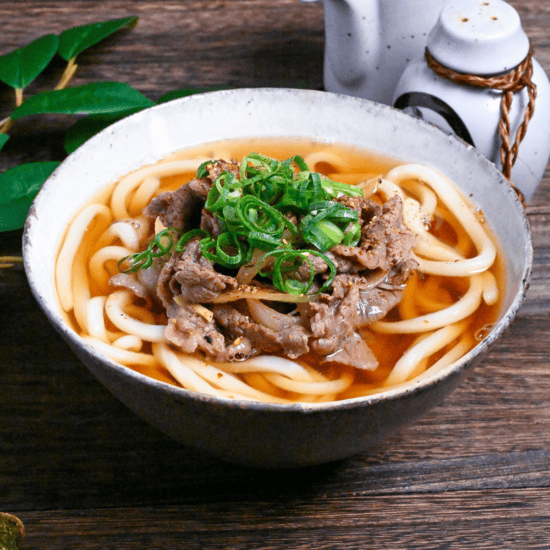




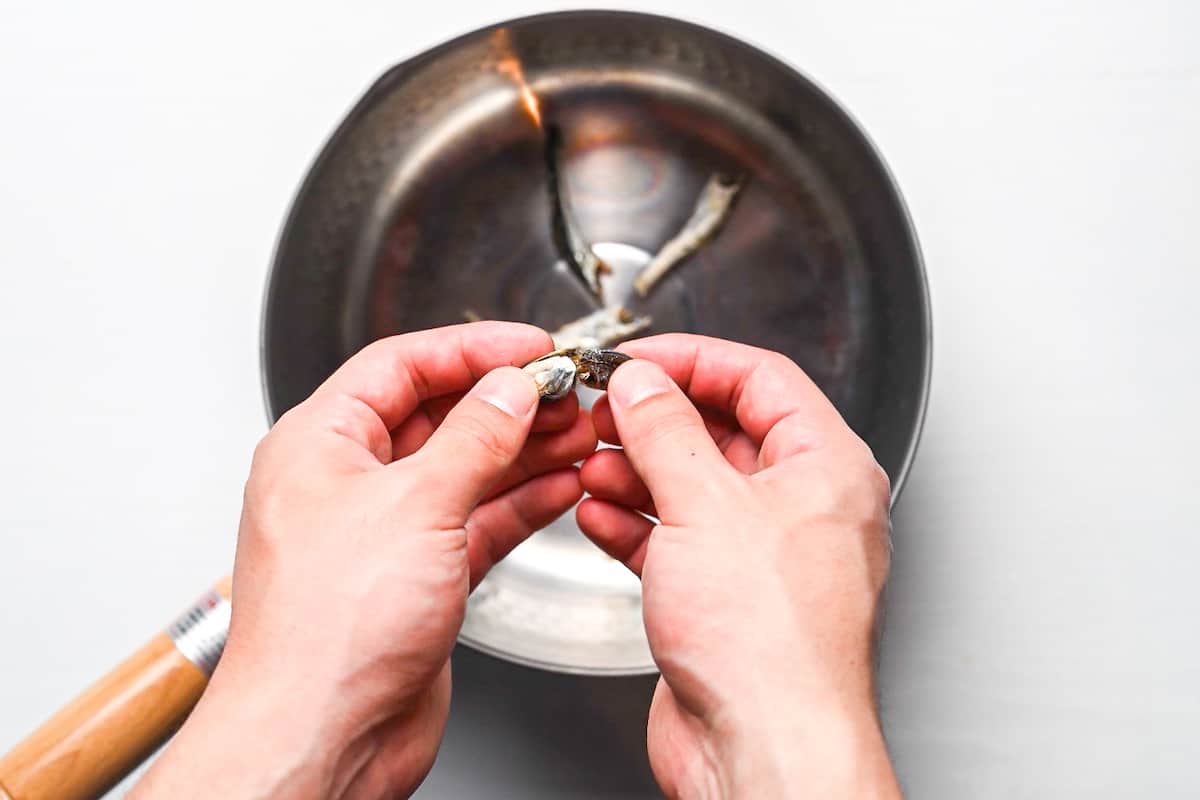
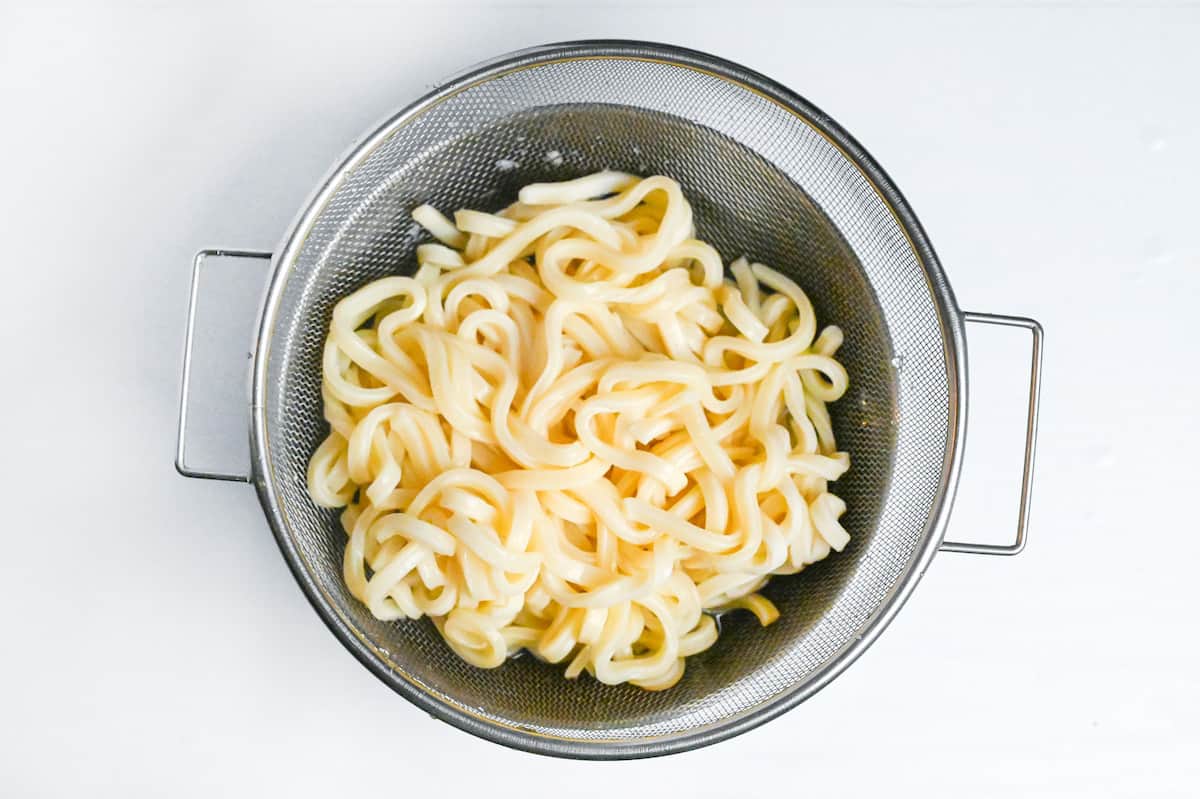
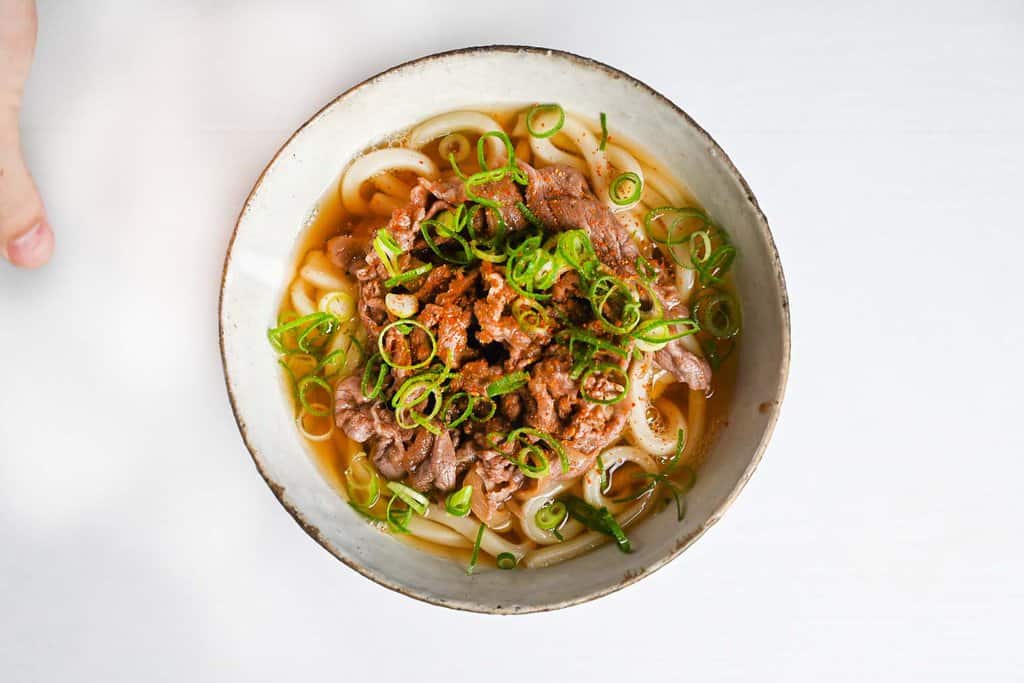
Great recipe and walkthrough, tried thus nany times with diffrent mest and it tastd great with all. When in a hurry i do it with bacon tofu also works but needs to marinate a bt longer pref over night and also add abit of togarashi for more taste. Thank you!
You’re welcome, thank you for trying the recipe! I’m glad you enjoyed it. It’s very interesting that you made it with bacon tofu, I’ll have to try that someday. Thanks for the tips!